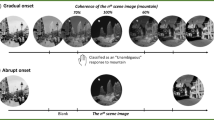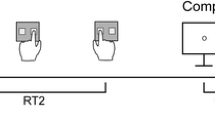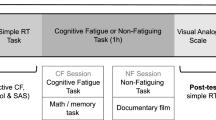Abstract
The efficiency of cognition is modulated by energetic factors like effort, fatigue or circadian variation, which affect even the most basic cognitive operations. For instance, speeded detection in simple reaction-time (SRT) tasks usually slows down over time. The literature suggests that either mindlessness due to routinization or mental fatigue due to attentional resource depletion might underlie this decrement. We tested these assumptions in three 25-min visual SRT tasks using easy-to-detect high-intensity and hard-to-detect low-intensity stimuli presented in both blocked and mixed fashion. Mindlessness theory predicts that less monotonous stimulation (i.e. the mixed presentation) would mitigate the time-related decrement for high- and low-intensity stimuli alike, whereas resource-depletion theory predicts opposite effects of mixed presentation on high- versus low-intensity stimuli. Indeed, stimulus intensity and presentation mode cross-interacted significantly, indicating that the performance decline was steeper for high-intensity stimuli but less steep for low-intensity stimuli during mixed compared to blocked presentation, respectively. These results strongly suggest that the time-related efficiency decrement during prolonged SRT performance is related to accumulating mental fatigue. A conjecture is put forward that explains both resource depletion and mindlessness from the perspective of self-regulation. Our study underscores the need to incorporate energetic factors into models of cognition to facilitate their translation into real-world applications.


Similar content being viewed by others
Notes
All major analyses were repeated based on individual median RT as the dependent variable, which yielded comparable results.
References
Aglioti, S., Smania, N., Barbieri, C., & Corbetta, M. (1997). Influence of stimulus salience and attentional demands on visual search patterns in hemispatial neglect. Brain and Cognition, 34, 388–403.
Banich, M. T., Burgess, G. C., Depue, B. E., Ruzic, L., Bidwell, L. C., et al. (2009). The neural basis of sustained and transient attentional control in young adults with ADHD. Neuropsychologia, 47, 3095–3104.
Banich, M. T., Milham, M. P., Atchley, R. A., Cohen, N. J., Webb, A., Wszalek, T., et al. (2000). Prefrontal regions play a predominant role in imposing an attentional ‘set’: evidence from fMRI. Cognitive Brain Research, 10, 1–9.
Baumeister, R. F., Vohs, K. D., & Tice, D. M. (2007). The strength model of self-control. Current Directions in Psychological Science, 16, 351–355.
Berlyne, D. E. (1960). Conflict, arousal, and curiosity. New York, NY: McGraw-Hill.
Buck, L. (1966). Reaction time as a measure of perceptual vigilance. Psychological Bulletin, 65, 291–304.
Cousineau, D. (2005). Confidence intervals in within-subjects designs: A simpler solution to Loftus and Masson’s method. Tutorial in Quantitative Methods for Psychology, 1, 42–45.
Davies, D. R., & Parasuraman, R. (1982). The Psychology of Vigilance. London: Academic Press.
Dockree, P. M., Kelly, S. P., Robertson, I. H., Roche, R. A., Reilly, R. B., & Foxe, J. J. (2005). Neurophysiological markers of alert responding during goal-directed behavior: A high-density electrical mapping study. NeuroImage, 27, 587–601.
Dockree, P. M., Kelly, S. P., Roche, R. A., Hogan, M. J., Reilly, R. B., & Robertson, I. H. (2004). Behavioural and physiological impairments of sustained attention after traumatic brain injury. Cognitive Brain Research, 20, 403–414.
Dreisbach, G., & Haider, H. (2008). That’s what task sets are for: shielding against irrelevant information. Psychological Research, 72, 355–361.
Eysenck, M. W. (1982). Attention and Arousal: Cognition and Performance. Berlin: Springer.
Fischer, T., Langner, R., Birbaumer, N., & Brocke, B. (2008). Arousal and attention: Self-chosen stimulation optimizes cortical excitability and minimizes compensatory effort. Journal of Cognitive Neuroscience, 20, 1443–1453.
Frith, C. D., & Done, D. J. (1986). Routes to action in reaction time tasks. Psychological Research, 48, 169–177.
Goschke, T., & Dreisbach, G. (2008). Conflict-triggered goal shielding: response conflicts attenuate background monitoring for prospective memory cues. Psychological Science, 19, 25–32.
Gottsdanker, R. (1975). The attaining and maintaining of preparation. In P. M. A. Rabbit & S. Dornic (Eds.), Attention and Performance V (pp. 33–49). London: Academic Press.
Grier, R. A., Warm, J. S., Dember, W. N., Matthews, G., Galinsky, T. L., Szalma, J. L., et al. (2003). The vigilance decrement reflects limitations in effortful attention not mindlessness. Human Factors, 45, 349–359.
Gustafson, R. (1986). Effect of small doses of alcohol and signal intensity on simple auditory reaction time in a monotonous test situation. Perceptual and Motor Skills, 63, 539–543.
Hancock, P. A. (1987). Arousal theory, stress and performance: Problems of incorporating energetic aspects of behavior into human-machine systems function. In L. S. Mark, J. S. Warm, & R. L. Huston (Eds.), Ergonomics and Human Factors: Recent Research (pp. 170–179). New York, NY: Springer.
Hancock, P. A., & Desmond, P. A. (Eds.). (2001). Stress, Workload, and Fatigue. Mahwah, NJ: Erlbaum.
Hancock, P. A., & Warm, J. S. (1989). A dynamic model of stress and sustained attention. Human Factors, 31, 519–537.
Helton, W. S., Hollander, T. D., Warm, J. S., Matthews, G., Dember, W. N., et al. (2005). Signal regularity and the mindlessness model of vigilance. British Journal of Psychology, 96, 249–261.
Helton, W. S., & Warm, J. S. (2008). Signal salience and the mindlessness theory of vigilance. Acta Psychologica, 129, 18–25.
Henderson, L., & Dittrich, W. H. (1998). Preparing to react in the absence of uncertainty: I. New perspectives on simple reaction time. British Journal of Psychology, 89, 531–554.
Hockey, G. R. J. (1986). A state control theory of adaptation to stress and individual differences in stress management. In G. R. J. Hockey, A. W. K. Gaillard, & M. G. H. Coles (Eds.), Energetics and Human Information Processing (pp. 285–298). Dordrecht: Nijhoff.
Hockey, G. R. J. (1997). Compensatory control in the regulation of human performance under stress and high workload: a cognitive-energetical framework. Biological Psychology, 45, 73–93.
Hockey, G. R. J., Coles, M. G. H., & Gaillard, A. W. K. (1986). Energetical issues in research on human information processing. In G. R. J. Hockey, A. W. K. Gaillard, & M. G. H. Coles (Eds.), Energetics and Human Information Processing (pp. 3–21). Dordrecht: Nijhoff.
Kane, M. J., & Engle, R. W. (2003). Working-memory capacity and the control of attention: the contributions of goal neglect, response competition, and task set to Stroop interference. Journal of Experimental Psychology: General, 132, 47–70.
Langner, R., Steinborn, M. B., Chatterjee, A., Sturm, W., & Willmes, K. (2010). Mental fatigue and temporal preparation in simple reaction-time performance. Acta Psychologica, 133, 64–72.
Lim, J., & Dinges, D. F. (2008). Sleep deprivation and vigilant attention. Annals of the New York Academy of Sciences, 1129, 305–322.
Lisper, H. O., & Ericsson, S. (1973). Effects of signal frequency on increase in reaction time in a 10-minute auditory monitoring task. Journal of Experimental Psychology, 98, 316–319.
Lisper, H. O., Kjellberg, A., & Melin, L. (1972). Effects of signal intensity on increase of reaction time on an auditory monitoring task. Perceptual and Motor Skills, 34, 439–444.
Lisper, H. O., Melin, L., Sjödén, P. O., & Fagerström, K. O. (1977). Temporal uncertainty of auditory signals in a monitoring task: Effects of inter-signal interval length and regularity on increase in reaction time. Acta Psychologica, 41, 183–190.
Lisper, H. O., & Törnros, J. (1974). Effects of inter-signal interval regularity on increase in reaction time in a one hour auditory monitoring task. Acta Psychologica, 38, 455–460.
Lorist, M. M., Klein, M., Nieuwenhuis, S., De Jong, R., Mulder, G., & Meijman, T. F. (2000). Mental fatigue and task control: planning and preparation. Psychophysiology, 37, 1–12.
Los, S. A. (1996). On the origin of mixing costs: Exploring information processing in pure and mixed blocks of trials. Acta Psychologica, 94, 145–188.
Manly, T., Heutink, J., Davison, B., Gaynord, B., Greenfield, E., Parr, A., et al. (2004). An electronic knot in the handkerchief: ‘Content free cueing’ and the maintenance of attentive control. Neuropsychological Rehabilitation, 14, 89–116.
Manly, T., Robertson, I. H., Galloway, M., & Hawkins, K. (1999). The absent mind: further investigations of sustained attention to response. Neuropsychologia, 37, 661–670.
Matthews, G., Campbell, S. E., Falconer, S., Joyner, L. A., Huggins, J., Gilliland, K., et al. (2002). Fundamental dimensions of subjective state in performance settings: Task engagement, distress, and worry. Emotion, 2, 315–340.
Matthews, G., Davies, D. R., Westerman, S. J., & Stammers, R. B. (2000). Human performance: Cognition, stress and individual differences. Hove: Psychology Press.
Matthews, G., & Desmond, P. A. (2002). Task-induced fatigue states and simulated driving performance. Quarterly Journal of Experimental Psychology, 55A, 659–686.
Matthews, G., Emo, A. K., & Funke, G. J. (2005). A short version of the Dundee Stress State Questionnaire. Poster presented at the 12th Meeting of the International Society for the Study of Individual Differences, Adelaide, Australia.
Miller, J. O., & Ulrich, R. (2003). Simple reaction time and statistical facilitation: a parallel grains model. Cognitive Psychology, 46, 101–151.
Mulder, G. (1986). The concept and measurement of mental effort. In G. R. J. Hockey, A. W. K. Gaillard, & M. G. H. Coles (Eds.), Energetics and Human Information Processing (pp. 175–198). Dordrecht: Nijhoff.
Müller, B., & Basler, H. D. (1993). Kurzfragebogen zur aktuellen Beanspruchung (KAB). Weinheim: Beltz.
Muraven, M., & Baumeister, R. F. (2000). Self-regulation and depletion of limited resources: Does self-control resemble a muscle? Psychological Bulletin, 126, 247–259.
Näätänen, R. (1972). Time uncertainty and occurrence uncertainty of the stimulus in a simple reaction time task. Acta Psychologica, 36, 492–503.
Nissen, M. J. (1977). Stimulus intensity and information processing. Perception and Psychophysics, 22, 338–352.
Nothdurft, H.-C. (2006). Salience and target selection in visual search. Visual Cognition, 14, 514–542.
Nuechterlein, K. H., Parasuraman, R., & Jiang, Q. (1983). Visual sustained attention: Image degradation produces rapid sensitivity decrement over time. Science, 220, 327–329.
Oldfield, R. C. (1971). The assessment and analysis of handedness: The Edinburgh inventory. Neuropsychologia, 9, 97–113.
Ollman, R. T., & Billington, M. J. (1972). The deadline model for simple reaction times. Cognitive Psychology, 3, 311–336.
Parasuraman, R. (1979). Memory load and event rate control sensitivity decrements in sustained attention. Science, 205, 924–927.
Pattyn, N., Neyt, X., Henderickx, D., & Soetens, E. (2008). Psychophysiological investigation of vigilance decrement: Boredom or cognitive fatigue? Physiology and Behavior, 93, 369–378.
Pfaff, D. W. (2006). Brain Arousal and Information Theory: Neural and Genetic Mechanisms. Cambridge, MA: Harvard University Press.
Posner, M. I. (1978). Chronometric Explorations of Mind. Englewood Hights, NJ: Erlbaum.
Posner, M. I., Cohen, Y., Choate, L. S., Hockey, G. R. J., & Maylor, E. (1984). Sustained concentration: Passive filtering or active orienting. In S. Kornblum & J. Requin (Eds.), Preparatory States and Processes (pp. 49–65). Hillsdale, NJ: Erlbaum.
Reynolds, J. H., Pasternak, T., & Desimone, R. (2000). Attention increases sensitivity of V4 neurons. Neuron, 26, 703–714.
Robertson, I. H., Manly, T., Andrade, J., Baddeley, B. T., & Yiend, J. (1997). “Oops!”: Performance correlates of everyday attentional failures in traumatic brain injured and normal subjects. Neuropsychologia, 35, 747–758.
Rogosa, D. R. (1995). Myths and methods: Myths about longitudinal research plus supplemental questions. In J. M. Gottman (Ed.), The Analysis of Change (pp. 3–66). Mahwah, NJ: Erlbaum.
Rogosa, D. R., & Willett, J. B. (1985). Understanding correlates of change by modeling individual differences in growth. Psychometrika, 50, 203–228.
Sanders, A. F. (1977). Structural and functional aspects of the reaction process. In S. Dornic (Ed.), Attention and Performance VI (pp. 3–25). Hillsdale, NJ: Erlbaum.
Sanders, A. F. (1983). Towards a model of stress and human performance. Acta Psychologica, 53, 61–97.
Sanders, A. F., Wijnen, J. L., & van Arkel, A. E. (1982). An additive factor analysis of the effects of sleep loss on reaction processes. Acta Psychologica, 51, 41–59.
Sarter, M., Gehring, W. J., & Kozak, R. (2006). More attention must be paid: the neurobiology of attentional effort. Brain Research Reviews, 51, 145–160.
Scerbo, M. (1998). What’s so boring about vigilance? In R. B. Hoffman, M. F. Sherrick, & J. S. Warm (Eds.), Viewing Psychology as a Whole: The Integrative Science of William N. Dember (pp. 145–166). Washington, DC: American Psychological Association.
See, J. E., Howe, S. R., Warm, J. S., & Dember, W. N. (1995). A meta-analysis of the sensitivity decrement in vigilance. Psychological Bulletin, 117, 230–249.
Smallwood, J., Davies, J. B., Heim, D., Finnigan, F., Sudberry, M., O’Conner, R., et al. (2004). Subjective experience and the attentional lapse: Task engagement and disengagement during sustained attention. Consciousness and Cognition, 13, 657–690.
Smallwood, J., & Schooler, J. W. (2006). The restless mind. Psychological Bulletin, 132, 946–958.
Smit, A. S., Eling, P. A. T. M., & Coenen, A. M. L. (2004). Mental effort causes vigilance decrease due to resource depletion. Acta Psychologica, 115, 35–42.
Smith, P. L. (1995). Psychophysically principled models of visual simple reaction time. Psychological Review, 102, 567–593.
Sturm, W., & Willmes, K. (2001). On the functional neuroanatomy of intrinsic and phasic alertness. NeuroImage, 14, 76–84.
Szalma, J. L., Hancock, P. A., Dember, W. N., & Warm, J. S. (2006). Training for vigilance: The effect of knowledge of results format and dispositional optimism and pessimism on performance and stress. British Journal of Psychology, 97, 115–135.
Szalma, J. L., Warm, J. S., Matthews, G., Dember, W. N., Wiler, E. M., Meier, A., et al. (2004). Effects of sensory modality and task duration on performance, workload, and stress in sustained attention. Human Factors, 46, 219–233.
Temple, J. G., Warm, J. S., Dember, W. N., Jones, K. S., LaGrange, C. M., & Matthews, G. (2000). The effects of signal salience and caffeine on performance, workload and stress in an abbreviated vigilance task. Human Factors, 42, 183–194.
Treisman, A., & Gormican, S. (1988). Feature analysis in early vision: Evidence from search asymmetries. Psychological Review, 95, 15–48.
Turatto, M., & Galfano, G. (2000). Color, form and luminance capture attention in visual search. Vision Research, 40, 1639–1643.
Van den Berg, J., & Neely, G. (2006). Performance on a simple reaction time task while sleep deprived. Perceptual and Motor Skills, 102, 589–599.
Van der Linden, D., Frese, M., & Meijman, T. F. (2003). Mental fatigue and the control of cognitive processes: Effects on perseveration and planning. Acta Psychologica, 113, 45–65.
Van der Molen, M. W. (1996). Energetics and the reaction process: Running threads through experimental psychology. In O. Neumann & A. F. Sanders (Eds.), Handbook of Perception and Action, Vol. 3: Attention (pp. 229–276). San Diego, CA: Academic Press.
Van Dongen, H. P. A., Maislin, G., Mullington, J. M., & Dinges, D. F. (2003). The cumulative cost of additional wakefulness: dose–response effects on neurobehavioral functions and sleep physiology from chronic sleep restriction and total sleep deprivation. Sleep, 26, 117–126.
Van Zomeren, A. H., & Brouwer, W. H. (1994). Clinical Neuropsychology of Attention. New York, NY: Oxford University Press.
Walker, A. D., Muth, E. R., Odle-Dusseau, H. N., Moore, D., & Pilcher, J. J. (2009). The effects of 28 hours of sleep deprivation on respiratory sinus arrhythmia during tasks with low and high controlled attention demands. Psychophysiology, 46, 217–224.
Warm, J. S., Parasuraman, R., & Matthews, G. (2008). Vigilance requires hard mental work and is stressful. Human Factors, 50, 433–441.
Weissman, D. H., Roberts, K. C., Visscher, K. M., & Woldorff, M. G. (2006). The neural basis of momentary lapses in attention. Nature Neuroscience, 9, 971–978.
Wesensten, N. J., Belenky, G., Kautz, M. A., Thorne, D. R., Reichardt, R. M., & Balkin, T. J. (2002). Maintaining alertness and performance during sleep deprivation: modafinil versus caffeine. Psychopharmacology, 159, 238–247.
West, R. (2001). The transient nature of executive control processes in younger and older adults. European Journal of Cognitive Psychology, 13, 91–105.
Wright, R. A., Junious, T. R., Neal, C., Avello, A., Graham, C., et al. (2007). Mental fatigue influence on effort-related cardiovascular response: Difficulty effects and extension across cognitive performance domains. Motivation and Emotion, 31, 219–231.
Wright, R. A., Stewart, C. C., & Barnett, B. R. (2008). Mental fatigue influence on effort-related cardiovascular response: Extension across the regulatory (inhibitory)/non-regulatory performance dimension. International Journal of Psychophysiology, 69, 127–133.
Wyatt, J. K., Ritz-De Cecco, A., Czeisler, C. A., & Dijk, D. J. (1999). Circadian temperature and melatonin rhythms, sleep, and neurobehavioral function in humans living on a 20-h day. American Journal of Physiology, 277, R1152–R1163.
Acknowledgments
Robert Langner was supported by the Deutsche Forschungsgemeinschaft (DFG, IRTG 1328). We thank Anita Koschmieder for help with data collection and Jan Lonnemann for technical assistance. We are grateful to William Helton, Bob Hockey, Michael Steinborn, Thomas Fischer and Susanne Leiberg for helpful comments on earlier versions of the manuscript.
Author information
Authors and Affiliations
Corresponding author
Rights and permissions
About this article
Cite this article
Langner, R., Willmes, K., Chatterjee, A. et al. Energetic effects of stimulus intensity on prolonged simple reaction-time performance. Psychological Research 74, 499–512 (2010). https://doi.org/10.1007/s00426-010-0275-6
Received:
Accepted:
Published:
Issue Date:
DOI: https://doi.org/10.1007/s00426-010-0275-6




